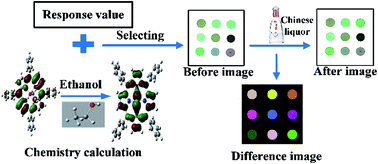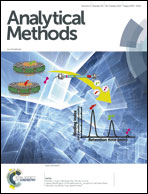In situ quantification of volatile ethanol in complex components based on colorimetric sensor array†
Abstract
This paper presents a novel method for selection of chemically responsive dyes and ethanol quantification in mixed volatile organic compounds (VOCs) using a colorimetric sensor array (CSA). Chemically responsive dyes (mainly composed of metalloporphyrins) which were sensitive to volatile ethanol were selected according to their response values when exposed to it. The mechanism by which the chemically responsive dyes combined with volatile ethanol was investigated based on quantum-chemical calculations. Then, a CSA composed of 5,10,15,20-tetraphenyl-21H,23H-porphine zinc (TPP-Zn) and 5,10,15,20-tetraphenyl-21H,23H-porphine manganese (TPP-Mn) derivatives, which exhibited specific sensitivity to volatile ethanol, was synthesized for measurement of the volatile ethanol content. A tri-CCD camera was employed to capture images of the CSA. The difference map of the sensor array before and after exposure to VOCs was obtained, and further processed and transformed into digital data for subsequent analysis, and used to build prediction models. The model with the optimal performance displayed a root mean square error of prediction (RMSEP) of 3.101 and a correlation coefficient (R) of 0.9571 in the prediction set. This work presents a newly developed CSA using sensitive dyes based on quantum-chemical calculations, which has significant potential in quantitative analysis of volatile organic compounds.



 Please wait while we load your content...
Please wait while we load your content...